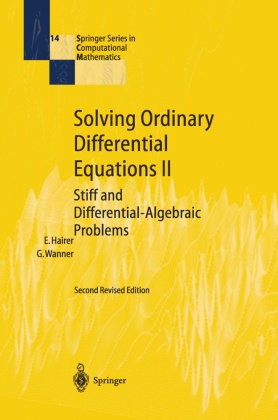
Solving Ordinary Differential Equations II - Stiff and Differential-Algebraic Problems
| Verlag | Springer |
| Auflage | 2010 |
| Seiten | 614 |
| Format | 15,4 x 23,7 x 3,5 cm |
| Gewicht | 926 g |
| Artikeltyp | Englisches Buch |
| Reihe | Springer Series in Computational Mathematics 14 |
| ISBN-10 | 3642052207 |
| EAN | 9783642052200 |
| Bestell-Nr | 64205220A |
"Whatever regrets may be, we have done our best." (Sir Ernest Shack 0 leton, turning back on 9 January 1909 at 88 23' South.) Brahms struggled for 20 years to write his first symphony. Compared to this, the 10 years we have been working on these two volumes may even appear short. This second volume treats stiff differential equations and differential algebraic equations. It contains three chapters: Chapter IV on one-step (Runge-Kutta) meth ods for stiff problems, Chapter V on multistep methods for stiff problems, and Chapter VI on singular perturbation and differential-algebraic equations. Each chapter is divided into sections. Usually the first sections of a chapter are of an introductory nature, explain numerical phenomena and exhibit numerical results. Investigations of a more theoretical nature are presented in the later sections of each chapter. As in Volume I, the formulas, theorems, tables and figures are numbered con secutively in each section and indicate, in addition, th e section number. In cross references to other chapters the (latin) chapter number is put first. References to the bibliography are again by "author" plus "year" in parentheses. The bibliography again contains only those papers which are discussed in the text and is in no way meant to be complete.
Inhaltsverzeichnis:
IV. Stiff Problems - One-Step Methods.- IV.1 Examples of Stiff Equations.- IV.2 Stability Analysis for Explicit RK Methods.- IV.3 Stability Function of Implicit RK-Methods.- IV.4 Order Stars.- IV.5 Construction of Implicit Runge-Kutta Methods.- IV.6 Diagonally Implicit RK Methods.- IV.7 Rosenbrock-Type Methods.- IV.8 Implementation of Implicit Runge-Kutta Methods.- IV.9 Extrapolation Methods.- IV.10 Numerical Experiments.- IV.11 Contractivity for Linear Problems.- IV.12 B-Stability and Contractivity.- IV.13 Positive Quadrature Formulas and B-Stable RK-Methods.- IV.14 Existence and Uniqueness of IRK Solutions.- IV.15 B-Convergence.- V. Multistep Methods for Stiff Problems.- V.1 Stability of Multistep Methods.- V.2 "Nearly" A-Stable Multistep Methods.- V.3 Generalized Multistep Methods.- V.4 Order Stars on Riemann Surfaces.- V.5 Experiments with Multistep Codes.- V.6 One-Leg Methods and G-Stability.- V.7 Convergence for Linear Problems.- V.8 Convergence for Nonlinear Problems.- V.9 Algebraic Stability of General Linear Methods.- VI. Singular Perturbation Problems and Index 1 Problems.- VI.1 Solving Index 1 Problems.- VI.2 Multistep Methods.- VI.3 Epsilon Expansions for Exact and RK Solutions.- VI.4 Rosenbrock Methods.- VI.5 Extrapolation Methods.- VI.6 Quasilinear Problems.- VII. Differential-Algebraic Equations of Higher Index.- VII.1 The Index and Various Examples.- VII.2 Index Reduction Methods.- VII.3 Multistep Methods for Index 2 DAE.- VII.4 Runge-Kutta Methods for Index 2 DAE.- VII.5 Order Conditions for Index 2 DAE.- VII.6 Half-Explicit Methods for Index 2 Systems.- VII.7 Computation of Multibody Mechanisms.- VII.8 Symplectic Methods for Constrained Hamiltonian Systems.- Appendix. Fortran Codes.- Driver for the Code RADAU5.- Subroutine RADAU5.- SubroutineRADAUP.- Subroutine RODAS.- Subroutine SEULEX.- Problems with Special Structure.- Use of SOLOUT and of Dense Output.- Symbol Index.
Rezension:
From the reviews of the second edition:
This is a superb book...Throughout, illuminating graphics, sketches and quotes from papers of researchers in the field add an element of easy informality and motivate the text." Mathematics Today
"This volume, on nonstiff equations, is the second of a two-volume set. This second volume treats stiff differential equations and differential-algebraic equations. ... This book is highly recommended as a text for courses in numerical methods for ordinary differential equations and as a reference for the worker. It should be in every library, both academic and industrial." (Teodora-Liliana Radulescu, Zentralblatt MATH, Vol. 1192, 2010)
